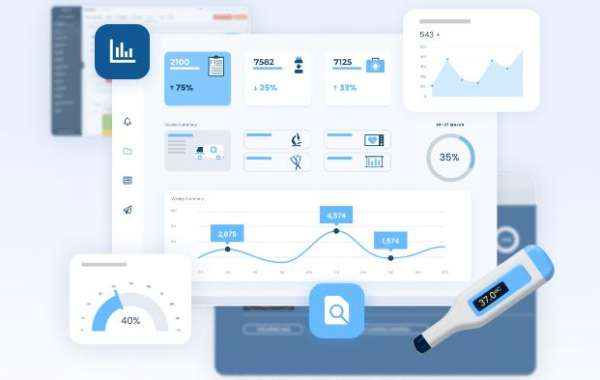The healthcare industry has undergone significant changes in recent years, primarily due to technological advancements. One of the most impactful innovations is pharmacy software development, which has transformed how pharmacies operate, enhancing efficiency, safety, and patient care. This article explores the evolution, components, benefits, challenges, and future trends in pharmacy software development.
1. Introduction to Pharmacy Software Development
Pharmacy software development refers to creating software solutions specifically designed for the pharmaceutical industry. These solutions streamline various processes, including prescription management, inventory control, billing, and patient engagement. The primary aim is to improve operational efficiency, enhance patient safety, and ensure compliance with regulations.
1.1 Historical Context
The evolution of pharmacy software can be traced back to the late 20th century when pharmacies began to adopt computerized systems. Initially, these systems focused on basic functions such as inventory management and billing. However, as the healthcare landscape evolved, the demand for more sophisticated solutions grew.
In the early 2000s, the advent of electronic health records (EHRs) and e-prescribing systems marked a significant turning point. Pharmacies started integrating these technologies, allowing for seamless communication between healthcare providers and pharmacists. Today, pharmacy software encompasses a wide range of functionalities designed to optimize pharmacy operations.
2. Key Components of Pharmacy Software
Modern pharmacy software systems typically consist of several critical components:
2.1 Prescription Management
Prescription management is at the heart of pharmacy software. This module allows pharmacists to receive, process, and dispense prescriptions efficiently. Key features include:
- E-Prescribing: Enables healthcare providers to send prescriptions electronically, reducing the risk of errors associated with handwritten prescriptions.
- Medication History Tracking: Maintains a comprehensive record of patients' medication history, ensuring that pharmacists can identify potential drug interactions and contraindications.
2.2 Inventory Management
Inventory management is essential for ensuring that pharmacies maintain optimal stock levels while minimizing waste. Key features of inventory management systems include:
- Automated Reordering: Alerts pharmacists when stock levels reach predefined thresholds, prompting timely reordering to avoid shortages.
- Expiration Date Monitoring: Tracks medication expiration dates to ensure that expired products are removed from shelves.
2.3 Patient Management
A robust patient management module is crucial for maintaining comprehensive patient records. This component typically includes:
- Patient Profiles: Stores essential patient information, including contact details, allergies, and medication history.
- Medication Counseling: Provides pharmacists with tools to offer personalized counseling based on patient-specific data.
2.4 Billing and Insurance Processing
Efficient billing and insurance processing are vital for pharmacy operations. This module helps pharmacies manage:
- Insurance Verification: Automates the process of verifying patient insurance coverage to minimize claim denials.
- Claims Management: Tracks and manages insurance claims, ensuring timely reimbursement.
2.5 Reporting and Analytics
Reporting and analytics tools provide valuable insights into pharmacy operations. Key features may include:
- Customizable Reports: Enables pharmacies to generate reports on various metrics, such as medication dispensing patterns and patient demographics.
- Performance Analytics: Tracks key performance indicators (KPIs) to assess operational efficiency and identify areas for improvement.
3. Benefits of Pharmacy Software Development
The adoption of pharmacy software brings numerous advantages, significantly impacting both pharmacy operations and patient care.
3.1 Enhanced Patient Safety
One of the most critical benefits of pharmacy software is improved patient safety. Automated systems reduce the risk of human error in medication dispensing, ensuring that patients receive the correct dosages and medications. Features such as drug interaction checks and allergy alerts further enhance safety, reducing the risk of adverse events.
3.2 Increased Efficiency
Pharmacies often handle high volumes of prescriptions and patient interactions. Software solutions automate various processes, such as prescription refills and inventory tracking, allowing pharmacy staff to focus more on patient care rather than administrative tasks. This increased efficiency leads to faster service, improved patient satisfaction, and reduced operational costs.
3.3 Regulatory Compliance
Pharmacies must adhere to numerous regulations, including those imposed by the Drug Enforcement Administration (DEA) and the Food and Drug Administration (FDA). Pharmacy software helps maintain compliance by automating reporting processes and ensuring that all necessary documentation is accurate and up to date. This reduces the risk of audits and penalties while promoting best practices in medication management.
3.4 Improved Communication
Effective communication between healthcare providers, pharmacists, and patients is crucial for optimal patient care. Pharmacy software often includes features that enable better communication through secure messaging systems, patient portals, and integration with electronic health records (EHRs). This connectivity enhances collaboration and ensures that all parties involved in a patient's care have access to relevant information.
3.5 Data-Driven Decision Making
Pharmacy software solutions facilitate the collection and analysis of data related to patient demographics, medication usage, and inventory levels. This data-driven approach enables pharmacies to make informed decisions, optimize operations, and tailor services to meet the needs of their patient population.
4. Challenges in Pharmacy Software Development
While the benefits of pharmacy software development are significant, several challenges must be addressed:
4.1 Integration with Existing Systems
Many pharmacies operate on legacy systems that may not easily integrate with new software solutions. Ensuring seamless interoperability between different systems can be a complex and time-consuming process, requiring significant investment in both time and resources.
4.2 User Training and Adoption
The successful implementation of pharmacy software relies on the willingness of staff to adopt new technologies. Comprehensive training programs must be developed to ensure that pharmacy personnel can effectively utilize the software, minimizing resistance to change.
4.3 Data Security Concerns
With the increasing reliance on digital systems comes the heightened risk of data breaches and cyberattacks. Pharmacy software developers must prioritize data security by implementing robust encryption, access controls, and regular security audits to protect sensitive patient information.
4.4 Regulatory Compliance
As regulations continue to evolve, pharmacy software must be designed to adapt to these changes. Staying compliant requires continuous updates and modifications to software systems, which can strain development resources.
4.5 High Development Costs
Developing custom pharmacy software can be expensive, especially for smaller pharmacies with limited budgets. It is essential for pharmacy owners to weigh the long-term benefits of investment against the initial costs.
5. Future Trends in Pharmacy Software Development
The future of pharmacy software development is shaped by emerging technologies and trends that promise to enhance pharmacy operations and patient care.
5.1 Artificial Intelligence and Machine Learning
AI and machine learning are expected to play a significant role in pharmacy software development. These technologies can enhance predictive analytics, improve medication adherence tracking, and optimize inventory management by analyzing historical data and predicting future trends.
5.2 Cloud-Based Solutions
Cloud-based pharmacy software is gaining popularity due to its scalability, accessibility, and cost-effectiveness. Pharmacies can leverage cloud solutions to store data securely, access applications remotely, and easily scale their operations without significant upfront investment.
5.3 Mobile Applications
The proliferation of smartphones has led to increased demand for mobile applications in healthcare. Pharmacy software developers are creating mobile-friendly solutions that allow patients to manage their prescriptions, communicate with pharmacists, and receive medication reminders directly on their devices.
5.4 Integration with EHRs
The integration of pharmacy software with electronic health records (EHRs) is becoming increasingly important. This connectivity allows for seamless sharing of patient information, improving care coordination and enhancing the overall patient experience.
5.5 Personalized Medicine
As the focus on personalized medicine grows, pharmacy software will need to adapt to support tailored medication regimens. Software solutions will increasingly incorporate genetic information and other patient-specific data to optimize treatment plans.
6. Case Studies: Successful Pharmacy Software Implementation
To illustrate the impact of pharmacy software development, let’s explore a few case studies showcasing successful implementations.
6.1 Case Study 1: Community Pharmacy
A community pharmacy in a suburban area faced challenges related to prescription management and patient engagement. By implementing a comprehensive pharmacy software solution, they automated prescription processing, streamlined inventory management, and enhanced patient communication.
The results were impressive: the pharmacy experienced a 30% reduction in prescription errors and a 25% increase in patient satisfaction scores. Additionally, the software’s analytics tools enabled the pharmacy to optimize inventory levels, reducing waste by 15%.
6.2 Case Study 2: Chain Pharmacy
A large chain pharmacy sought to standardize operations across its locations. The organization implemented a centralized pharmacy management system that integrated e-prescribing, inventory management, and patient management.
This initiative resulted in improved compliance with regulatory requirements and enhanced operational efficiency. The chain reported a 40% reduction in administrative overhead and increased the speed of prescription processing, leading to higher patient retention rates.
6.3 Case Study 3: Specialty Pharmacy
A specialty pharmacy focused on high-cost medications faced challenges in managing patient care and adherence. They adopted a pharmacy software solution with features tailored to specialty medications, including medication therapy management and patient monitoring.
The software enabled pharmacists to proactively manage patient adherence, resulting in a 20% improvement in medication compliance rates. Patients reported greater satisfaction with the personalized support they received, leading to improved health outcomes.
7. Conclusion
Pharmacy software development is transforming the pharmaceutical landscape by enhancing patient safety, streamlining operations, and ensuring regulatory compliance. As the healthcare industry continues to evolve, pharmacies must embrace technological advancements to remain competitive and deliver high-quality patient care.
While challenges exist, the benefits of implementing robust pharmacy software solutions far outweigh the obstacles. By investing in modern software, pharmacies can improve efficiency, enhance patient engagement, and ultimately contribute to better health outcomes. As the industry moves forward, the integration of emerging technologies such as AI, cloud computing, and mobile applications will further revolutionize pharmacy operations, paving the way for a more efficient and patient-centered healthcare system.














